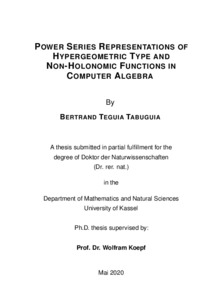| dc.date.accessioned | 2020-06-17T13:20:16Z | |
| dc.date.available | 2020-06-17T13:20:16Z | |
| dc.date.issued | 2020-06-10 | |
| dc.identifier | doi:10.17170/kobra-202006031323 | |
| dc.identifier.uri | http://hdl.handle.net/123456789/11598 | |
| dc.description.sponsorship | DAAD Erasmus+ program between AIMS-Cameroon and Kassel University, DAAD STIBET | |
| dc.language.iso | eng | |
| dc.rights | Namensnennung - Nicht-kommerziell - Weitergabe unter gleichen Bedingungen 4.0 International | * |
| dc.rights | Namensnennung - Nicht-kommerziell - Weitergabe unter gleichen Bedingungen 4.0 International | * |
| dc.rights.uri | http://creativecommons.org/licenses/by-nc-sa/4.0/ | * |
| dc.subject | m-fold Hypergeometric Term, Holonomic Functions, Hypergeometric Type Functions, Laurent-Puiseux Series | eng |
| dc.subject.ddc | 500 | |
| dc.title | Power Series Representations of Hypergeometric Type and Non-Holonomic Functions in Computer Algebra | eng |
| dc.type | Dissertation | |
| dcterms.abstract | A Laurent-Puiseux series
$$ \sum\limits_{n = n_0}^{\infty }{a_n (z - z_0)^{n/k} (a_n \in K, k \in ℕ, n_0 \in ℤ ) } \quad (1) $$
where $ k $ denotes the corresponding Puiseux number and $ K $ an infinite computable field - mostly $ K= ℚ(α_1,\ldots,α_n) $ : a field of rational functions in several variables, is mainly characterized by the general coefficient. We consider the case where an is a term of an m-fold hypergeometric sequence.
That is $ a_{n+m} = r(n) a_n $ for all sufficiently large integers $ n, r(n) $ is a rational function over $ K $, and m is a positive integer. A Laurent-Puiseux series with an $ m $-fold hypergeometric sequence as general coefficient is said to be of hypergeometric type, with type $ m $. We call hypergeometric type function any expression (mostly meromorphic) that can be written as a hypergeometric type series.
To find the general coefficient in (1) of a given hypergeometric type function, three key steps are to be considered (see [1]). Given an expression $ f $ ,
1. find a holonomic differential equation (DE) satisfied by $ f $;
2. deduce a holonomic recurrence equation (RE) satisfied by the Taylor coefficients of $ f $;
3. find all m-fold hypergeometric term solutions of the obtained RE.
Last but not least, the series representation is handled by determining the linear combination of all the resulting hypergeometric type series provided some initial values using Taylor approximation of suitable order.
The understanding of these three steps is essential for our work. In [1], Koepf described the first two steps for getting holonomic recurrence equations of any given hypergeometric type function. But the third step was not complete as he considered three sub-families of hypergeometric type functions: exp-like functions, rational functions, and the functions whose recurrence equation obtained in step 2 is a two-term recurrence relation. In this thesis, we clearly solve the third step and develop a complete algorithm to compute power series of linear combinations of hypergeometric type functions by using a new algorithm which finds all m-fold hypergeometric term solutions of holonomic recurrence equations. Also, we investigate an algorithm to represent power series of non-holonomic and non-hypergeometric type functions like $ \tan (z), \frac{1 + \tan(z)}{1-\tan(z)} , \frac{z}{\exp(z)-1} , \frac{\tan^{-1}(z)}{z+1} , \exp(z²+z),\: etc.$
In addition, we confirm the asymptotically fast behavior of an algorithm based on holonomic recurrence equations to compute Taylor expansions of holonomic functions (see [2], Chapter 10), and present some interesting results for the automatic proof of certain identities that are generally difficult to prove (see [2], Chapter 9) like
$$ \frac{1+\tan(z)}{1-\tan(z)} = \exp \left(2 \tanh^{-1}\left(\frac{\sin(2z)}{cos(2z)+1}\right) \right) $$
by characterizing non-holonomic functions with non-linear recurrence equations and some initial values.
Our implementations are done in the computer algebra system (CAS) Maxima 5.37.2, and regrouped in our package FPS. The CAS Maple is also used for comparison in order to show the improvement given by our algorithms and their implementations.
References
[1] Koepf, W.: Power series in computer algebra. Journal of Symbolic Computation 13, 1992, 581-603
[2] Koepf, W.: Computeralgebra. Eine algorithmisch orientierte Einführung. Springer, Berlin-Heidelberg, 2006, ISBN 3-540-29894-0 | eng |
| dcterms.accessRights | open access | |
| dcterms.creator | Teguia Tabuguia, Bertrand | |
| dcterms.dateAccepted | 2020-05-27 | |
| dcterms.extent | VIII, 215 Seiten | |
| dc.contributor.corporatename | Kassel, Universität Kassel, Fachbereich Mathematik und Naturwissenschaften, Institut für Mathematik | |
| dc.contributor.referee | Koepf, Wolfram (Prof. Dr.) | |
| dc.contributor.referee | Seiler, Werner M. (Prof. Dr.) | |
| dc.relation.issupplementedby | The Maxima package FPS.mac | |
| dc.subject.swd | Computeralgebra | ger |
| dc.type.version | publishedVersion | |
| kup.iskup | false | |


